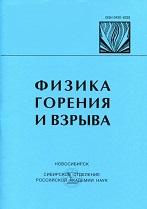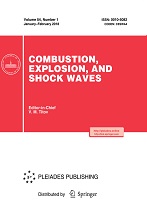|
This article is cited in 25 scientific papers (total in 25 papers)
Energy efficiency of a continuous-detonation combustion chamber
S. M. Frolovabc, V. S. Aksenovabc, A. V. Dubrovskiiabc, V. S. Ivanovab, I. O. Shamshinabc
a Center of Pulse Detonation Combustion, Moscow, 119991, Russia
b Semenov Institute of Chemical Physics, Russian Academy of Sciences, Moscow, 119991, Russia
c MEPhI National Research Nuclear University, Moscow, 115409, Russia
Abstract:
Systematic experimental and computational studies of the energy efficiency of continuous-detonation combustors (CDCs) have been performed. A small-size and a large-size CDCs using hydrogen as fuel and oxygen or air as oxidizer have been developed and tested. It was first experimentally proved that the Zel'dovich thermodynamic cycle with continuous-detonation combustion of a hydrogen-oxygen mixture in an annular combustor is more efficient than the Brayton thermodynamic cycle with continuous combustion of the mixture, other things being equal. The specific impulse of a small-size bench-scale rocket engine with a 50 mm diameter CDC operating in the continuous-detonation mode was 6–7% higher than that in the continuous combustion mode of operation. The measured fuel specific impulse for the large-size CDC of 406 mm diameter running on a hydrogen-air mixture was at a level of 3000 s. Three-dimensional calculations to optimize the structure and operation mode of the large-size CDC have shown that when running on a combustible mixture with a nearly stoichiometric integral composition, the specific impulse can be increased to $\approx$ 4200 s.
Keywords:
continuous-detonation combustor, energy efficiency, experiment, three-dimensional calculation.
Received: 23.09.2014
Citation:
S. M. Frolov, V. S. Aksenov, A. V. Dubrovskii, V. S. Ivanov, I. O. Shamshin, “Energy efficiency of a continuous-detonation combustion chamber”, Fizika Goreniya i Vzryva, 51:2 (2015), 102–117; Combustion, Explosion and Shock Waves, 51:2 (2015), 232–245
Linking options:
https://www.mathnet.ru/eng/fgv217 https://www.mathnet.ru/eng/fgv/v51/i2/p102
|


| Statistics & downloads: |
| Abstract page: | 28 | | Full-text PDF : | 20 |
|





 Contact us:
Contact us: Terms of Use
Terms of Use
 Registration to the website
Registration to the website Logotypes
Logotypes








 Citation in format
Citation in format 
